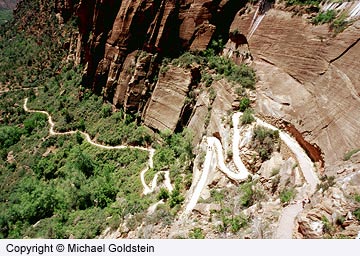
The Angel’s Landing Trail winds up (and down!) from the West Rim Trail, which leaves from “The Grotto” in Zion National Park. En route, one hikes through “Walter’s Wiggles”, a famous series of man-made switchbacks that allow access to the upper part of the trail.
The elevation change from the Grotto to Angel’s Landing is almost 1500 feet. Most hikers will make it as far as Scouts Lookout, a 1000-foot elevation change on a relatively easy trail. The last 500 feet take you up an extremely steep and rough trail, and even with the assistance of a chain, all but the most daring prefer to ‘give it a miss’… I used the excuse of “dangling camera equipment”, but there was no way this ‘flatlander’ was going up there!
The “bird’s-eye-view’ is always effective in photographing mountain trails, and if some hikers can be placed in a strategic location for scale and focus, so much the better.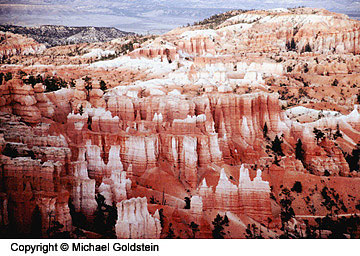
This image, made in the very last of the evening light at Bryce Canyon, was done from the Rim Trail, just outside Zion Lodge – and I left a thick steak and a glass of wine to make it!
A Singh-Ray enhancing filter was used, as well as a polarizing filter, as I wanted to ensure that the salmon colour of the rock, one of the chief features of the Canyon, was enhanced. My 24mm zoom lens allowed a good scope of the Canyon to be included, while a small aperture ensured a good depth of field. Only use of the tripod, and a shutter-release cable, allowed me a very long exposure, in making this photograph.
Photographs like this are a valuable contribution to a “photo essay” on a hiking trip, or as an addition to future company catalogues. After all, it’s vistas like these that draw us to travel in the first place, and a good photo is worth a thousand words …
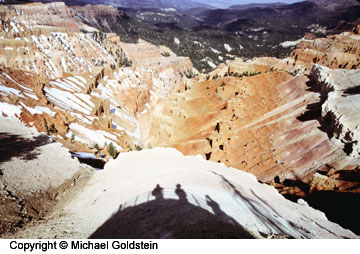
This image was made at Cedar Breaks National Monument, at the ten-thousand foot elevation level, where we arrived several days after a huge late snowstorm had closed the park! The park had just been re-opened, and large snowdrifts still lined the roads.
I’ve used this compositional ploy on a number of occasions – not showing the audience, who are admiring some vista or activity, but only their shadows, and allowing the viewer’s imagination to do the rest. It’s not an opportunity that arises very often, and it usually requires a very wide-angle lens to exploit it properly.
The relative size of the human figures lends scale to the scene, which encompasses an area of many square miles. Having the dark shadow silhouette show up against a huge snowbank was just a nice gift, from the god of photographers.
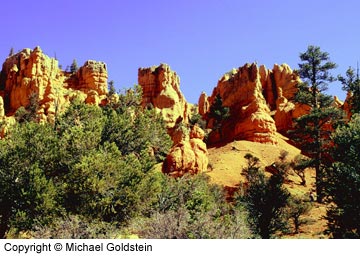
Everyone who goes to Bryce Canyon must pass through Red Canyon, a phenomenal sight in itself, just outside the Bryce Canyon area. Bryce seems to ‘get all the press’. Almost everyone is so intent on arriving at Bryce, they hardly notice the marvellous country through which they are driving – everyone but the photographers, of course! Red Canyon even has its own arches, on the Mossy Cave Trail, easily photographed from the trail with a long lens.
This image was made using a blue-yellow polarizer, which made the red rocks positively glow in mid-morning light. The road through the Canyon twists and turns, and every turn yields a different composition, and different light.
While I was not able to convince the hike leader to stop in mid-flight, and let me photograph for several hours, I was able to go back for a morning after the walk had finished, and exposed several rolls in this relatively small area.
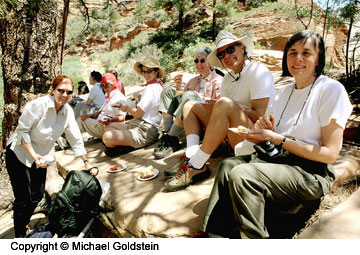
This was perhaps the best of the group shots I made, during our hike together in Utah. It was done at Scout Lookout, on the Angel’s Landing trail in Zion National Park, when the entire group had re-assembled for lunch before heading back down the trail.
Everyone is relaxed, (the worst is behind us!), and ready to enjoy a meal. A little fill flash helped the “hatbrim shadows”, while a wide-angle lens let me get really close, and still include the entire party. A lower point of view helped make this a dynamic composition.

Leave a Reply